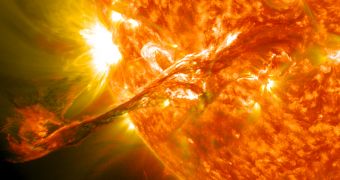Officials with the United Kingdom government recently announced plans of funding the construction of a new space-weather forecasting service, which will allow the country to respond swiftly in case the Sun releases a devastating flare, storm or coronal mass ejection (CME).
Space weather is the name given to the multitude of effects the Sun has on our planet. When the star becomes highly active, such as during the peak period of its 11-year cycle, it can release powerful flares and CME that can bypass Earth's magnetic defenses.
These events release so much radiation that everything from the International Space Station, its crew and orbital satellites to power grids on the surface of the planet can be adversely affected. Luckily, these flares take some time to reach us, which should theoretically give us time to prepare.
What the UK government seeks to accomplish is the construction of an early warning system, which would enable the nation to shutdown – or otherwise protect – critical infrastructure and assets from the harsh effects of space weather, Nature reports.
Representatives of the Met Office, which is in charge of the effort, say that solar storms can trigger radio blackouts, affect data accuracy from the Global Positioning System, and disrupt power services.
Met Office space weather business manager Mark Gibbs explained recently that the new center would act as a back-up to the American Space Weather Prediction Center (SWPC), in Boulder, Colorado which is currently being operated by experts with the National Weather Service (NWS). The NWS is a division of the US National Oceanic and Atmospheric Administration (NOAA).
The new UK forecasting system is scheduled to become operational sometime in April 2014, after the effort has received £4.6 million ($7.5 million / €5.45 million) from the government over three years.
The center will not be providing subscription services for business, like the SWPC does. Interestingly, the number of subscribers the American center has has increased dramatically, from 5,000 in 2007 to 37,000 this year.
“Now is the right time to invest in space-weather forecasting capability,” UK science minister David Willetts said recently. The new system will gather and centralize data from satellites operated by NASA and the European Space Agency (ESA).

 14 DAY TRIAL //
14 DAY TRIAL //